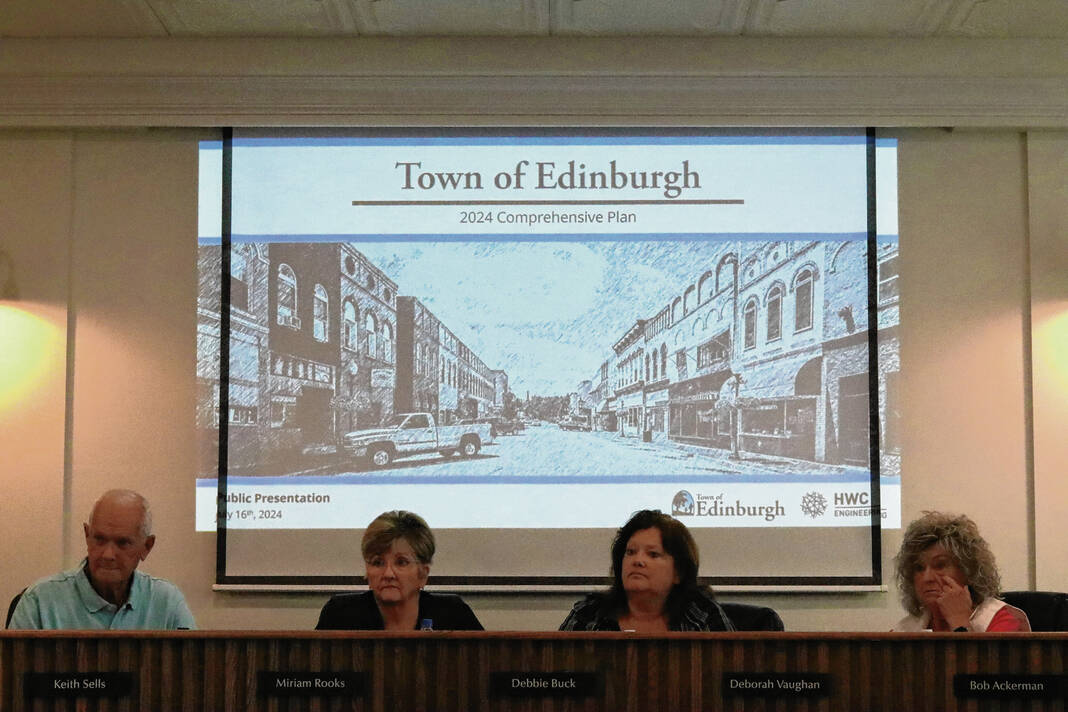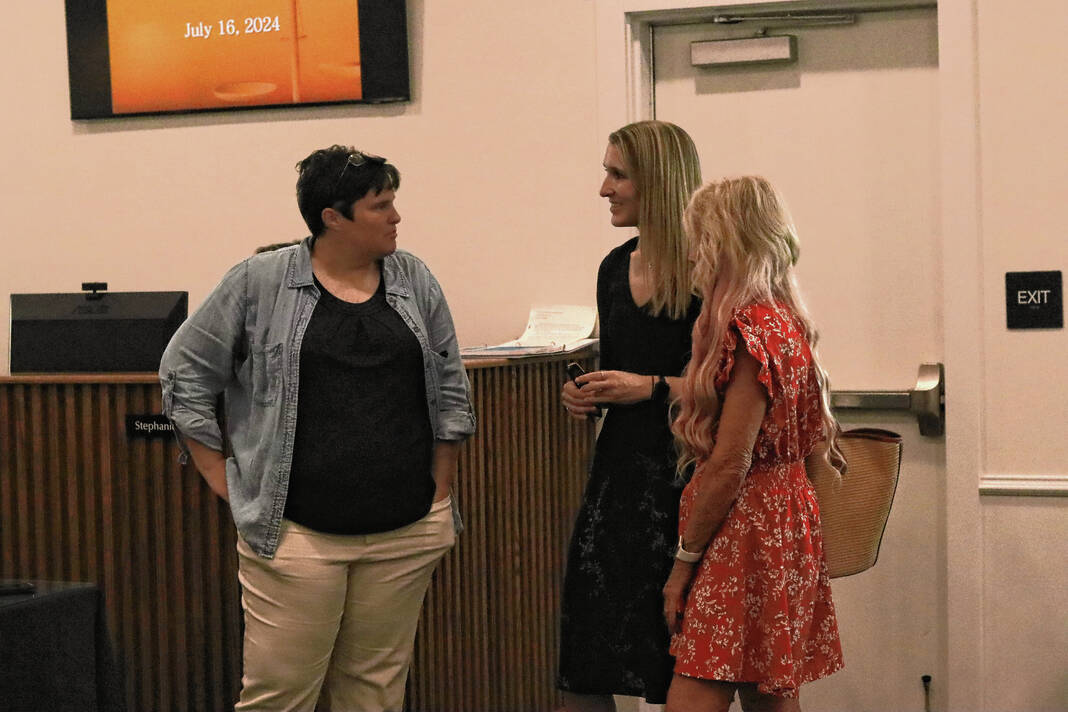Residents can now give feedback on Edinburgh’s draft comprehensive plan, which will steer the town’s growth and direct future land use.
HWC Engineering presented the public draft of the new Edinburgh Comprehensive Plan to the plan commission on Tuesday. The aim was to gather feedback from residents and town officials as the plan heads toward adoption later this summer.
The planning process started in January. HWC Engineering has focused on gathering public feedback and data through focus groups, a workshop, the Big Ideas Open House, stakeholder meetings and more.
“The feedback that we got from community members really shaped the vision, goals and action items that ended up in that final plan,” said Genevieve Zircher, planner with HWC Engineering.
The team heard from over 460 voices, she said. Staff held focus groups with 25 participants, a public workshop with 13 participants, an open house with 31 participants, a survey with 400 responses and a project website that has been viewed by 333 unique users.
From feedback, HWC Engineering staff determined there were several emerging themes from the public: community pride and identity, a desire for downtown revitalization, a need for a variety of housing options, placemaking and infrastructure, recreation and youth engagement.
There are several steps to the adoption process for the plan. It will again go before the plan commission on Aug. 20 and the town council on Sept. 9, pending review by the Indiana Office of Rural and Community Affairs, or OCRA. The plan must also be reviewed by OCRA because the town received a grant from the state agency to help fund the plan.
Here are some key points covered in the plan:
Government and fiscal capacity
Town officials received feedback that encouraged them to foster an engaged citizenry through improved communication and expanded participation opportunities, and to expand the capacity of town departments.
Community members said they value transparency and were largely dissatisfied with citizen engagement and participation, primarily among teens and young adults. They were also unsatisfied with the town government’s communication, according to the draft plan.
Alongside streaming and creating an online portal for the town council, planning commission and zoning board of appeals meetings, people recommended the town add QR codes to yard signs so community members can learn about proposed changes.
Another suggestion was to create opportunities for youth to get involved in government by launching a youth task force and developing student internship opportunities, among other action items, the plan shows.
Placemaking
Community members expressed a desire to improve downtown, enhance gateways into town, attract new development and beautify the town while maintaining its historic character, according to the draft plan. Based on that feedback, it is recommended that town officials promote Edinburgh as a unique destination and invest in strategic capital improvements.
Some ideas include collaborating with Festival Country Indiana, installing wayfinding signage along main corridors and enhancing streetscapes downtown and along main corridors.
Others recommendations include establishing a public greenspace downtown to accommodate community events, using public art to enhance downtown and partnering with college and high school students to create social media content for the town, the plan says.
Economic development
Town residents said they are dissatisfied with retail, restaurant, entertainment and job opportunities in town, according to survey responses as shown in the draft plan.
To accomplish these things, plan developers recommend revitalizing Edinburgh’s downtown district, supporting existing businesses and entrepreneurs and collaborating with neighboring counties to attract new employers.
Plan developers recommend establishing a Main Street organization, creating a downtown business attraction program, amending the zoning ordinance to limit residential uses to upper stories in traditionally commercial areas downtown and acquiring and repurposing vacant lots downtown for uses like infill development, flexible greenspace and visitor parking.
Housing
Survey respondents indicated Edinburgh needs more diverse housing options, but said town officials should focus on rehabilitating existing housing first, according to the draft plan. Nearly half of respondents were dissatisfied with property maintenance.
Plan developers came up with two goals along those lines: support the development of new housing options of various types and prices and promote the beautification of existing neighborhoods through local enforcement and grassroots volunteerism.
To do this, town officials are encouraged to update the zoning and subdivision control ordinance and identify possible incentives to attract residential development such as Housing Tax Increment Financing, among other ideas.
For beautification, developers want Edinburgh officials to create an action plan for enforcement in key areas like gateway corridors and historic districts, develop an online ordinance violation portal, consider developing a Residential Rental Inspection Program and establish a rehabilitation program for residential properties, among other action items.
Transportation
Developers proposed goals to continue to maintain and strategically improve the transportation network and strengthen local and regional connectivity by enhancing the bicycle and pedestrian network.
Recommendations include developing a Bicycle and Pedestrian Master Plan, completing a Sidewalk and Curb Ramp Inventory and an asset management plan for local roadways.
There are also ideas to coordinate with business and property owners to develop an action plan for public parking downtown and partner with nearby parks and recreation departments to connect trails in the region, according to the draft.
Agriculture
The plurality of survey respondents, 44%, said existing agricultural land within Edinburgh should be developed in the future, but 36% disagreed and 21% were unsure what should be done, the draft says.
Plan developers say the town can direct growth and development with appropriate transitions to agricultural areas in the unincorporated county. They propose requiring buffers between agricultural and non-agricultural uses in the zoning and subdivision control ordinance, adding more food vendors to the farmer’s market and attracting agriculture-related businesses through economic development partnerships.
Parks and recreation
Residents asked for more programming in the town’s parks and more connectivity between parks and town amenities, according to the draft plan.
To build on that feedback, plan developers propose establishing a parks board, a Five-Year Parks and Recreation Master Plan and a park volunteer group.
To build upon existing recreation amenities, recommendations include exploring opportunities to acquire vacant parcels downtown to create future park amenities like a public plaza, flexible greenspace or pocket park.
Town officials are also encouraged to update development standards to support the use of floodplains for public recreation and open space, and require new subdivisions to offer park amenities within the development if it is not within walking distance of an existing park, recreational area or open space.
Historical and archaeological resources
Although a majority of survey respondents agreed that historic buildings should be prioritized, some respondents indicated they were not satisfied with the town’s current efforts to preserve its history or educate residents and visitors on that history, according to the draft plan. Over half of respondents are unaware of available resources to rehabilitate historic buildings.
With the goals of restoring and reusing historic buildings and sharing the town’s history and heritage, plan developers encourage town officials to consider establishing a historic overlay district and connect business owners with incentives for the rehabilitation and reuse of commercial buildings downtown.
Other recommendations include holding a historic tour of the town, as well as partnerships with the Johnson County Museum of History and Bartholomew County Historical Society.
How to give feedback
Edinburgh residents are invited to give feedback on the plan by July 29. To view the full draft, visit edinburghcompplan.com.
Contact HWC: Reach Rachel Christenson, planning project manager at HWC Engineering, at 317-519-8510 and [email protected].
Comment online: Comments through the “Contact Us” page on the project website.











